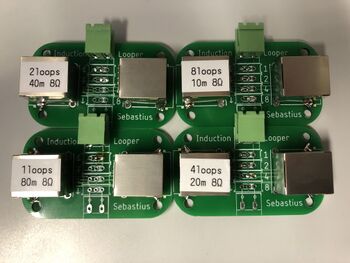Induction looper: Difference between revisions
No edit summary |
No edit summary |
||
| Line 43: | Line 43: | ||
* pls no EMPs when turning it on | * pls no EMPs when turning it on | ||
[An example of a relatively simple Class A-ish OTA](http://tinyurl.com/tp4p4my) | |||
to be made into wiki-compatible text: | to be made into wiki-compatible text: | ||
Revision as of 17:32, 22 February 2020
| Project Induction Looper | |
|---|---|

| |
| Induction Loop audio on the cheap and easy | |
| Status | In progress |
| Contact | sebastius, pwuts, noor |
| Last Update | 2020-02-22 |
Plan is to make a really cheap and really portable induction loop system that we can just give to conferences for free. That will enable them to help hearing impared visitors listen in to talks via the t-coil in their hearing aids. Sidequests include using these systems to create secret audio spots for quests and other stuff.
Original inspiration for the project: https://spectrum.ieee.org/geek-life/hands-on/a-diy-audio-induction-loop-for-the-hard-of-hearing
Sebastius designed a little board that allows configurable amount of loops. Prototypes have fixed settings, switches are still underway from China.
Board files: https://github.com/sebastius/inductionlooper
First test was very successful!
Electronics
For the driving electronics, there are basically two options:
- using a regular audio amplifier and matching the impedance of the adjusted loop so the amplifier doesn't shit itself
- using/building a transconductance amplifier and optimize the loop for low impedance
Using a regular audio amp
This is, in terms of electronics, the easiest way. It requires an amplifier (of course) and a loop with 8 ohms of impedance.
Transconductance amplifier
This is how it's done professionally. A circuit that takes voltage at the input and outputs a current proportional to the input voltage.
After some searching it seems Ali doesn't have them, so this is going to be a DIY board. Making a simple Class B transconductance amplifier can be done with an OP-AMP, a FET or BJT and a resistor. It's the sensible (additional) requirements that make it complicated:
- it needs to output both the positive and negative halves of the signal, not just the positive half
- volume control would be nice
- pls no EMPs when turning it on
[An example of a relatively simple Class A-ish OTA](http://tinyurl.com/tp4p4my)
to be made into wiki-compatible text:
I'll just respond to @JennyList and @NoorDraconia in one go: with some help of Benadski I changed a capacitor on the EM sniffer so it's better for low frequencies. As a result I could actually hear the transmitted sound over the EM noise coming from the wall. It's still not really an induction loop tester though, so I would advise against using it as some kind of reference. If the signal must be received in a certain space, one can make two loops at any two opposing ends (and maybe one in the middle if the other two are at the short ends) or one loop around the whole room. To get an idea of signal distribution and decay, use this: https://www.falstad.com/vector3dm/ ("current loop", "loop pair stacked", "rectangular loop"). People with hearing aids can't be expected to stay stationary which must (I think) be reckoned with for signal distribution and thus placement of the loops. Apologies again for a wall of text :P



